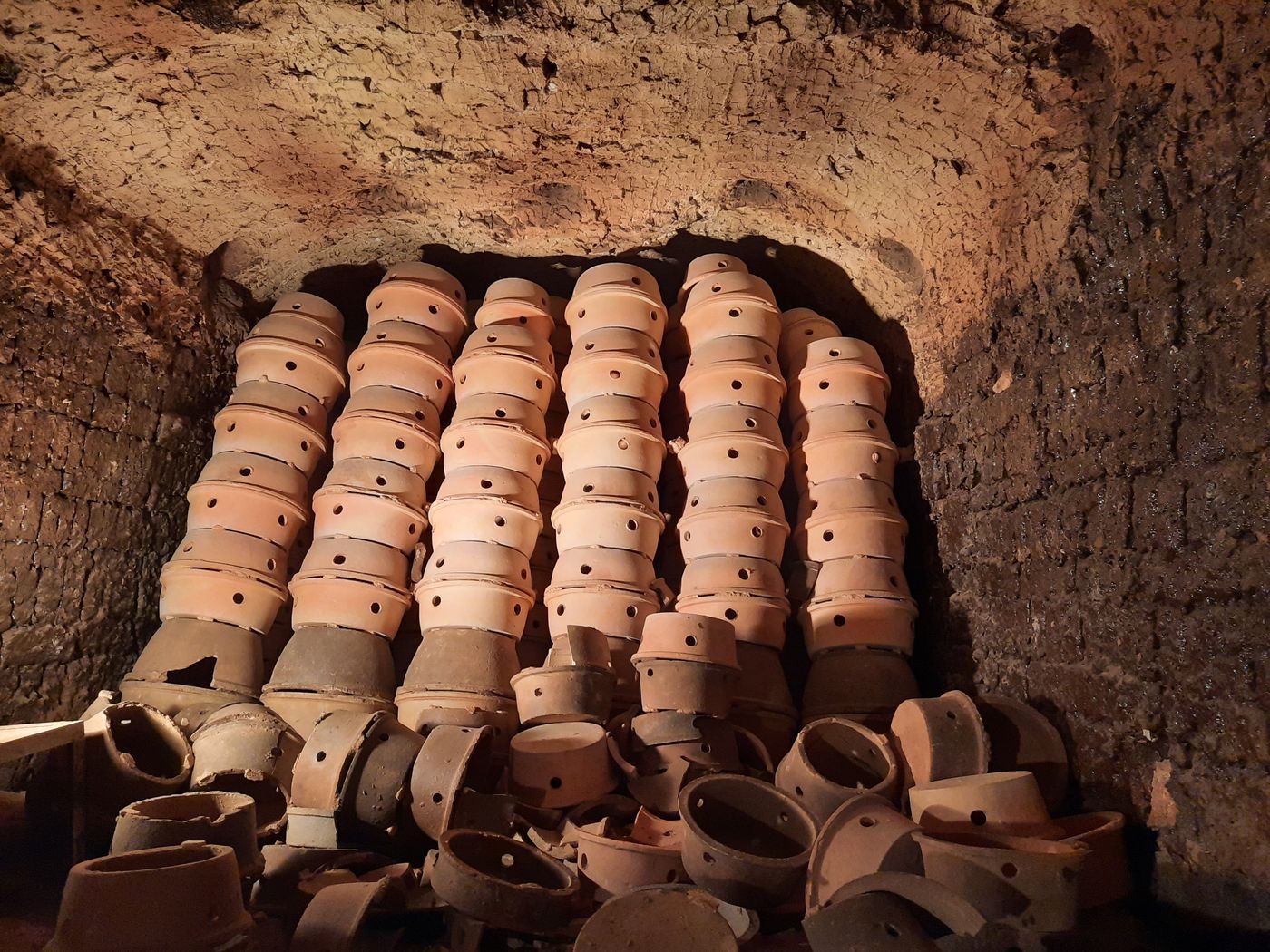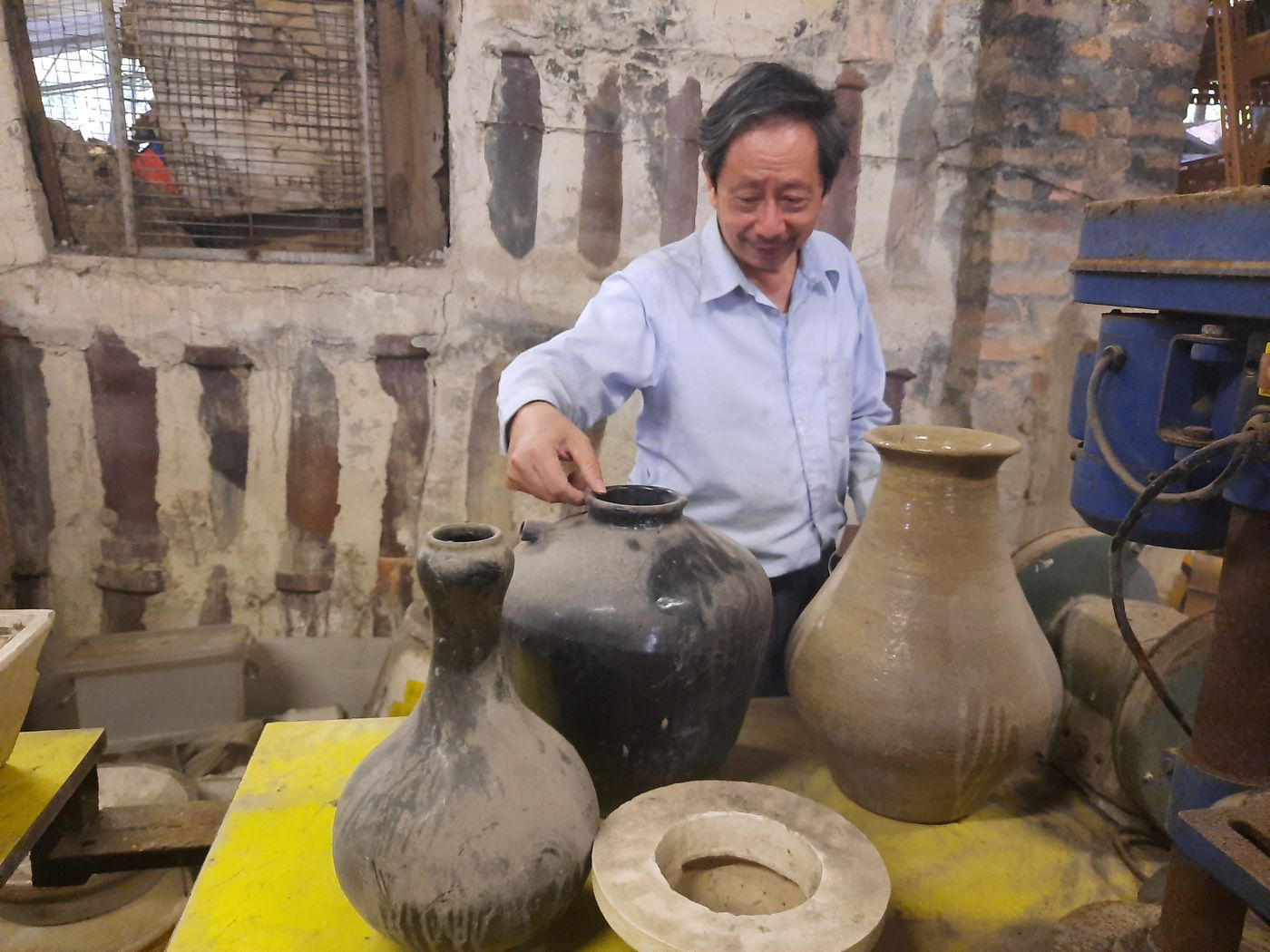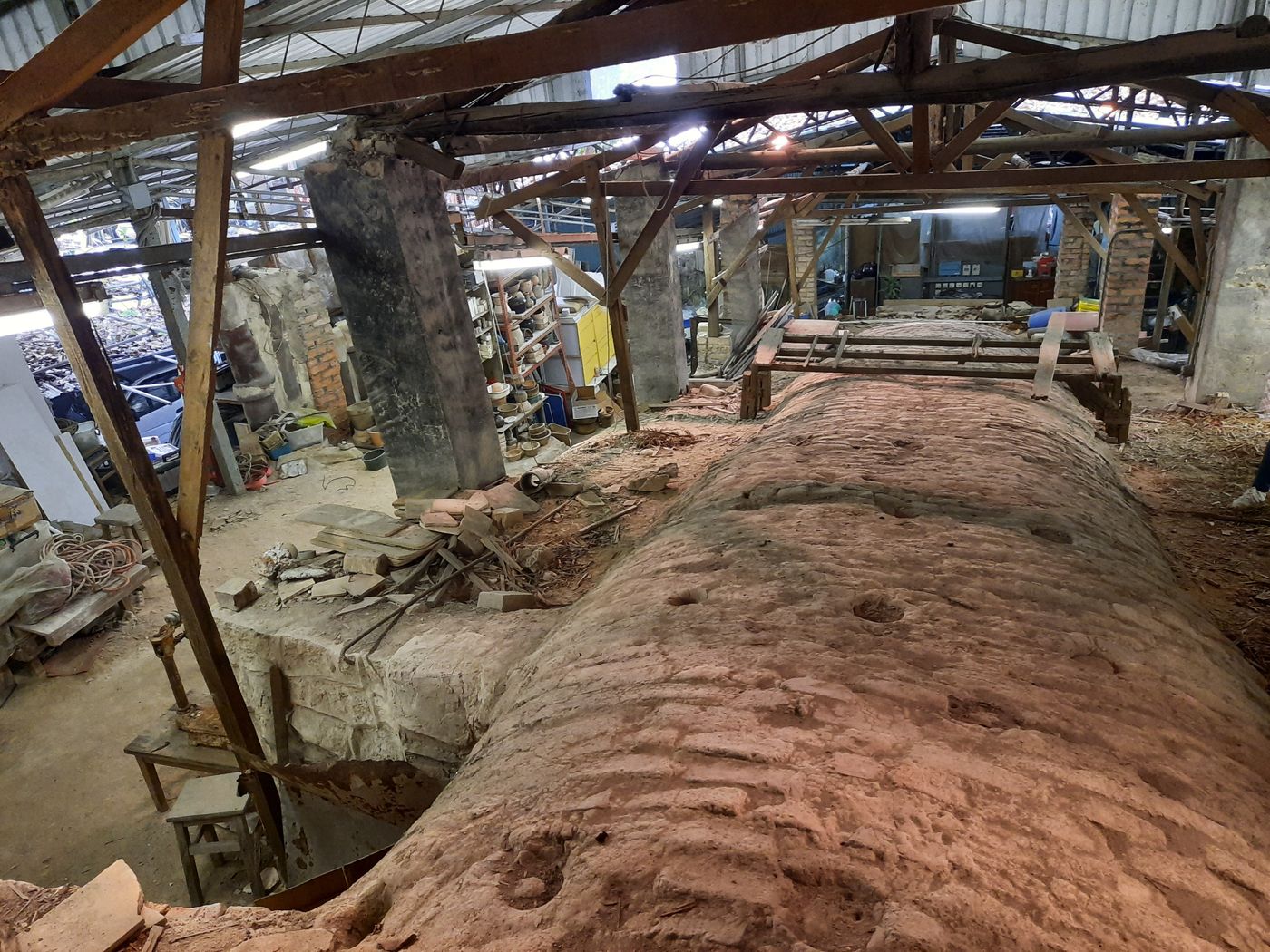The last generation of kiln keepers in Hong Kong guard the Castle Peak Dragon Kiln

The only remaining dragon kiln in Hong Kong
We passed through the open-air parking lot and came to a semi-open slope with a giant trellis for shade and rain. All kinds of pottery that had been sealed for a long time were piled up everywhere, just like an archaeological site. Surrounded by these "unearthed cultural relics" was a A kiln with a history of about 80 years and a length of 20 meters.
The first time I saw a real kiln in my memory was the Nanfeng ancient stove in Shiwan, Foshan. At that time, I was not particularly interested in kilns. I just thought that the most “ceramic” produced in Shiwan today is toilets, and I felt a little disappointed. It was only after I read Junji Ito's horror manga "The Kiln Change" that I became interested in this craft of fire and earth. Today, the Qingshan Dragon Kiln in front of me is in the same line with the development of Shiwan pottery in terms of appearance and history.
Ceramic lovers will not be unfamiliar with "kiln". The "kiln" can be said to be the "womb" of ceramics. Whether the kiln is in good condition and whether the firewood absorbed is enough for the throat also directly affects the shape and color of the utensils. In northern China and Japan, the most common kilns are in the shape of steamed buns, while in southern China, "Dragon kilns" are mostly used due to the terrain. The dragon kiln is built on the mountain, and the kiln body made of mud bricks is elongated and shaped like a dragon. The oldest dragon kiln in China is the Warring States Dragon kiln in Zengcheng, Guangzhou. The Castle Peak Dragon Kiln in Hong Kong does not have such a long history, but it was built by adhering to the craftsmanship of the ancient Shiwan Kiln, which was built as early as the 1940s. We walked along the passage next to the "back" of the dragon kiln. The kiln bricks are still strong, the firewood holes are evenly distributed, and the kiln head, kiln chamber, kiln roof and chimney are quite sound. Although it was discontinued in 1982, the structure is still intact. It can be seen that the craftsmanship of the kiln builders in the past can make the body of bricks and tiles go through the wind and frost without major damage. The surrounding facilities, such as mud training pools and sedimentation pools, can still be used as long as they are slightly repaired. It is absolutely technically possible to restart the kiln.
As early as the 1940s, there were more than ten kilns in Tuen Mun, but the only one that has survived the baptism of time is the current Castle Peak Dragon Kiln, which has become the only existing dragon kiln in Hong Kong with a complete structure.

The past and present of Hong Kong pottery industry
The current "guardian" of the Dragon Kiln is Liang Boquan, the son of Shiwan pottery master Liang Sen. Liang Boquan himself is a graduate of the Department of Economics of the Chinese University, and he was also an accountant. After Liang Sen passed away in the 1980s, he returned to manage the kiln that was already dying. At that time, the Long Kiln had transformed into the business of selling glaze and pottery clay to local potters. However, Liang Sen's childhood and growth in the Longyao are an addendum to the history of local ceramics.
What did the dragon kiln ever produce? "It's all rough." Liang Boquan said disapprovingly. The "rough stuff" in his mouth is still not considered a work of art, but no matter how you go to an antique store or an auction website, these "rough stuff" have become valuable today. Wujiapi wine bottles, buckets of crickets, and ancient money poppies with access to no exits, today are all searched by bosom friends, as well as wood-fired porridge pots, incense burners, urinals, and even gold pagodas, pottery produced by dragon kilns, Take care of people's life, old age, sickness and death.
Hong Kong once had a history of ceramic manufacturing that should be recorded in the annals of history, but it has never been rectified. Hong Kong has also created countless pottery. Perhaps the level of art is not attractive to museums or collectors, but these folk art products are the carrier of many Hong Kong memories.
Liang Boquan's father Liang Sen was originally a Shiwan pottery master and came to Hong Kong in 1949. At that time, Tuen Mun already had the initial form of light industry. Today’s Kin Sang Village was the Kin Sang Brick Factory in its previous life. It was the largest ceramic industry center in Hong Kong from the start of production in 1933 to the shutdown in 1963. The current location of the dragon kiln was built in the 1940s by Situ Nutao, a businessman from Kaiping, but the real operator was Liang Sen. He continued the kiln firing techniques of Shiwan, and at the same time, he modified part of the structure of the dragon kiln and simplified the process according to local conditions. Adapt to local needs.
The dragon kiln in Liang Boquan's memory is full of bitterness, and it also reflects the blood and sweat history of several generations of pottery craftsmen in Hong Kong: "My father was the "commander-in-chief" of the kiln. Because the temperature of the kiln head and kiln tail is different, it is all based on experience as to which position to put it in. There were dozens of potters in the heyday of Long Kiln, and even children like us had to help. Plate, my sister and I do the most is the clay pot lid. Burning the kiln is a cool labor, not only chopping wood, but also concentrating on controlling the kiln fire. The process takes at least ten hours. It is extremely hot in summer, but potters still have to wear thick clothes The coat looks at the kiln fire to prevent burns, and the activity that can cool myself is to go to the beach for swimming. At that time, I walked out to Qingshan Bay. Winter is also bitter, the clay is as cold as ice, and frostbite on my hands and feet is normal, so we need to Leaning against the 1300-degree kiln head to take a bath and warm up with natural heating.”

Revitalize ancient kilns into community museums
Qingshan Dragon Kiln was rated as a third-level historical building by the Ancient Consultation Association in 2014, but in fact, as early as the early 1980s, people of insight had already seen the cultural and historical value of Dragon Kiln. In 1982, Dr Solomon Bard, who was a wonderful person in the fields of medicine, music and archaeology in Hong Kong and was the executive secretary of the Antiquities and Monuments Office at the time, discovered this kiln. The kiln was turned into a Living Museum. He even took Mrs. Youde to visit the dragon kiln, affirming the value of the dragon kiln, and pointed out that "its architecture that follows the ancient design is unique not only in Hong Kong, but also in the neighboring areas. If it can be preserved. , should try to keep it working."
However, the good times were short-lived. Although the then Governor of Hong Kong, Sir Edward Youde, supported the revitalization of dragon kilns, the government also took the initiative to study relevant methods. However, in 1983, Dr. Bai De retired, Youde died in 1986, and in 1988, the kiln owner Liang Sen also passed away. Although the Architectural Services Department had completed the sketch of the revitalization of the dragon kiln at that time, the departure of the helmsman made it difficult to realize the wish of revitalization. In 2018, the government began to reclaim land for the development of public housing. One of the sites was only 30 meters away from the Dragon Kiln, which made the Dragon Kiln attract the attention of the local pottery circle again.
Liu Wanshan is the vice chairman of the Hong Kong Dragon Kiln Concern Group. In 2015, she and a group of local potters began to notice the dragon kiln. Before the outbreak of the plague, the concern group occasionally held guided tours to let everyone see the kiln. style. The government repossessed the land, and they feared that the project would destroy the only remaining intact dragon kiln in Hong Kong. In addition, Liu Wanshan pays more attention to the future conservation of Long Kiln. "If a monument is just placed here without any interaction with the community, it is a lifeless history. We hope that the dragon kiln can be turned into a living museum, open to the public, and even re-burning the dragon kiln to become a landmark for the community again. ”
A 20-meter-long kiln, even in the era of mass production, required one or two months to fill the entire kiln with enough product. Today, even if the dragon kiln has a complete structure, there is not enough pottery products, and it is difficult to re-fire it. Liu Wanshan said: "Actually, you can refer to the pottery festival in Japan. In some ancient kilns, the firing schedule is opened once or twice a year, and the fired objects will be sold in the pottery festival. There are workshops and local handmade specialties. , is one of the ways to unite community strength and cultural heritage.”
The dragon kiln uses natural firewood to make pottery. There is no high technology. It depends on the experience of the craftsman. By observing the color of the flame and the temperature of the firewood injection hole, you can judge whether the kiln fire is just right. Next to the dragon kiln, I saw a box of dusty "pig gallbladder bottle-shaped" wine bottles with the engraving of Yongliwei at the bottom. It was the wine bottle in the early days of the winery. Compared with the same wine bottles that are now mass-produced in China, this Liang Boquan "Rough" in the mouth, no matter the color or shape, is actually not rough at all. When you get it in your hand, you can feel how solid the work of the craftsman was.
The original article appeared in the June 2020 issue of Hong Kong Economic Journal
Like my work? Don't forget to support and clap, let me know that you are with me on the road of creation. Keep this enthusiasm together!

- Author
- More